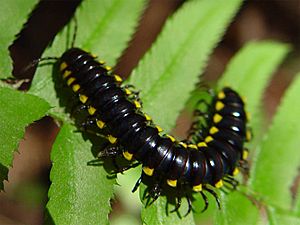Segmentation facts for kids
Segmentation in biology means that an animal or plant body is divided into a series of repeating parts or sections. Think of it like a train with many carriages, where each carriage is a segment. This feature is found in many successful animal groups.
Some common examples include:
- Arthropods: Like insects, spiders, and crabs. Their bodies are clearly divided into segments.
- Vertebrates: Animals with backbones, like humans, fish, and birds. Their backbones (vertebral columns) are made of many small segments called vertebrae.
- Annelids: These are segmented worms, such as earthworms. Their bodies are made of many similar rings.
Having a segmented body is very useful. It allows different parts of the body to develop for different jobs. For example, some segments might be for movement, while others are for feeding or breathing.
How Segmentation Develops
Scientists have learned a lot about how segmented animals grow. This process is controlled by special instructions found in their genes.
Control Genes and Body Plans
A scientist named E.B. Lewis studied fruit flies. He found a group of important genes that control how the body segments form. These genes act like a master plan for building the animal. They make proteins that tell other genes what to do. This helps guide how cells develop into different body parts.
What's really cool is that the order of these control genes on a chromosome matches the order of the body parts they create. For example, a gene at the beginning of the cluster might control the head, while a gene at the end controls the tail.
The Homeobox Mystery
Each of these important control genes contains a special part called a homeobox. This homeobox is a very old and similar DNA sequence found in almost all higher animals. This suggests that these control genes are very ancient. They likely came from a single gene that copied itself many times over millions of years.
E.B. Lewis believed that by comparing these control genes across different animals, we could learn how animals themselves have changed and developed over time. It helps us understand the amazing variety of life on Earth!
See also
 In Spanish: Segmentación para niños
In Spanish: Segmentación para niños



